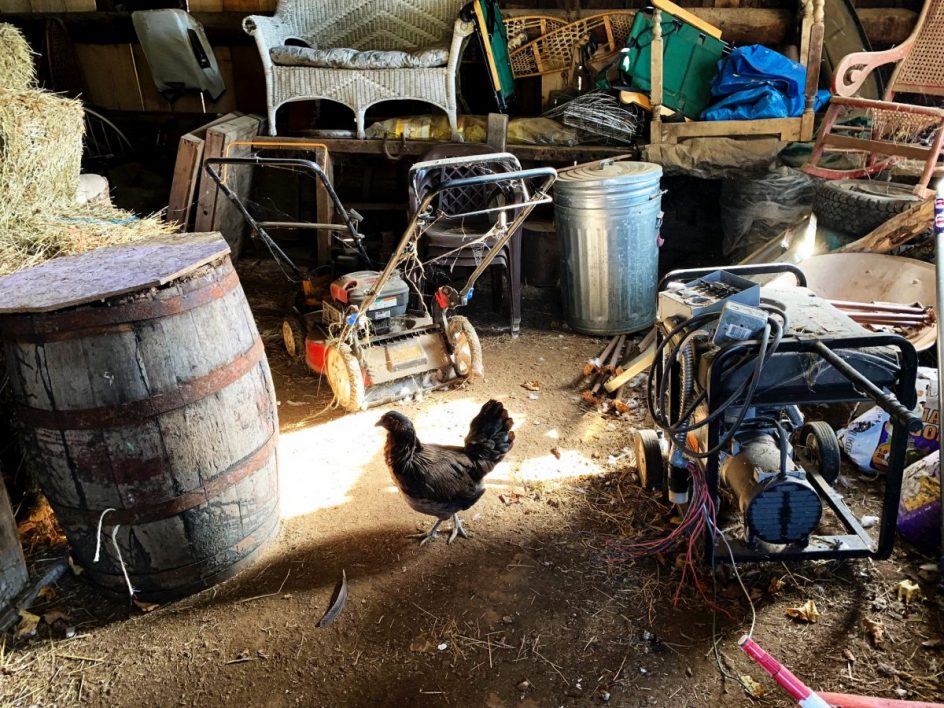
Chickens are an iconic image on a farm, they speak clearly to a life with animals, a life in nature, a life on a farm. Chickens are now illegal in most urban and suburban areas of America, they are considered too dirty to share the earth with human beings.
This, after chickens have fed us in many different ways, they remind us our past, our history, our connection to the earth.
I love seeing them parading back and forth in the big barn.
Chickens as we know them date back to at least 2000 B.C. and their ancestry can be traced back to four species of wild jungle fowl from Southeast Asia.
The Red jungle fowl (Gallus gallus or Gallus bankiva) is the most commonly found wild species in the world today and is the main ancestor of the domestic chicken we know.
After centuries of breeding and selection, chickens now exist in many colors, sizes and shapes – more than 350 combinations. while the purebred exhibition industry continued to select and breed fowl for standard show and plumage colors, the commercial industry developed specialized hybrids for meat and egg production.
Today, the purebred fowl are basically the same as they were 100 years ago and are mainly raised as a hobby, but the commercial poultry industry has developed into a mass production science, producing nutritious meat and eggs with astonishing efficiency, and some say, epidemic cruelty.
The banning of chickens throughout urban America is yet another sign of our growing disconnection with animals and nature.
It’s okay to eat them and their eggs, but they can’t legally be anywhere around most of us. It seems for 2,000 years humans survived living alongside of chickens, but are now considered too frail.
We live with chickens every day, and it is nothing but a gift. We are all alive to talk about it.
I think we take chickens for granted, but here on our farm, they are a symbol to us, and nothing speaks more clearly about them then when they walk into a barn, on any real farm a kind of dust-gathering museum of farm life.
We need a wiser understanding of animals than this.
The story of the farm is all over the barn, the chickens are one of our primary symbols.

I have chickens, but I do understand why many people are reluctant to have chickens
in their urban neighbhoods. They can be dirty and smelly, if unkempt. I think that’s a
public health issue to be dealt with on an individual basis. Some people think of them as
rural and they don’t want to be rural. I know some see chickens as a sign of poverty. They
say their poor grandparents ate them because they didn’t have anything else.
It’s not about being afraid of chickens or wanting to banish animals from their lives. To many
it’s the idea of what’s appropriate for the situation.
In my area near Dallas, many of the suburbs allow chickens, but no roosters and a limited number.
That seems a good compromise.
I love chickens. They are cheerful, resourceful, and have fed my children and I with both eggs and meat for the many years I was a single mother raising four kids. They also provided really good fertilizer for the large garden that fed us summer and winter (I did much canning!). Nothing is as marvelous as a hen singing her morning song as she hunts bugs in the yard. One cannot help but smile . I had a Banty hen as a pet when I lived for a very short time in a snooty suburb in NJ. I told neighbors it was a rare breed of parrot. LOL
Keeping hens but not roosters is legal in the city of Troy, and perhaps Albany as well. Roosters are thought to be too noisy & therefore annoying to neighbors. Nevertheless, I know that some folks keep a rooster as well. I remain nervous around chickens thanks my cousin’s big Rhode Island Red that chased me to the top of the swingset & wouldn’t let me get down when I was a child.
Chickens are an important food source on my farm. Of all the animals I keep they are the least expensive and the most productive. Not only do they produce eggs and meat, they grow quickly and reproduce easily.